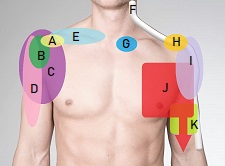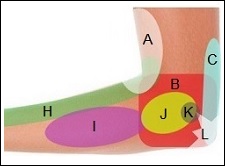- Home
- Wrist Pain Diagnosis
- Carpal Tunnel Syndrome
Carpal Tunnel Syndrome
Written By: Chloe Wilson BSc (Hons) Physiotherapy
Reviewed By: SPE Medical Review Board
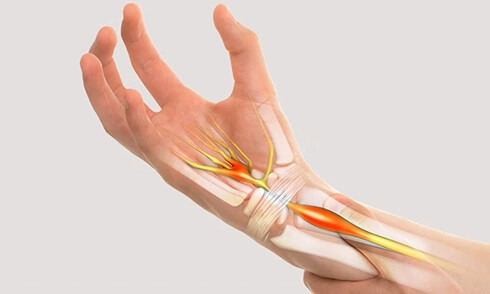
Carpal tunnel syndrome (CTS) is a common condition that causes pain, numbness, and tingling in the wrist and hand.
It occurs when the median nerve is squashed as it runs through the carpal tunnel in the wrist.
CTS can significantly impact daily activities, making it difficult to grip objects, type, or perform other routine tasks.
Understanding the causes, symptoms, and treatment options for carpal tunnel syndrome is essential for managing and preventing this condition effectively.
What Is Carpal Tunnel?
The carpal tunnel is a narrow passageway, located on the palm side of the wrist. It is around 1 inch wide. Think of it like a road tunnel through a mountain. The carpal tunnel space is formed by:
- Bones: four of the carpal (hand) bones form the floor of the tunnel, known as the deep carpal arch. This concave surface is made up of the pisiform and hamate bones on the pinky side and the scaphoid and trapezium bones on the thumb side
- Fascia: the flexor retinaculum, aka transverse carpal ligament, is a layer of thick connective tissue which forms the roof of the tunnel
These structures are quite rigid, meaning the carpal tunnel cannot really stretch, so there is limited space in the tunnel.
A number of structures travel through the carpal tunnel:
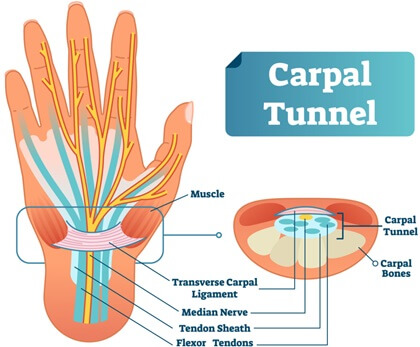
- Median Nerve: is the most superficial structure running through the top part of the carpal tunnel space. The nerve runs from the neck, through the upper arm, down the front of the forearm and into the hand, where it splits forming multiple branches supplying the thumb and middle three fingers
- Flexor Tendons: nine tendons pass through the carpal tunnel. Flexor pollicis longus has its own tendon sheath (covering), and the four flexor digitorum superficialis tendons and four flexor digitorum profundus tendons all share a common tendon sheath.
Carpal Tunnel Problems
When the space within the carpal tunnel becomes restricted, the median nerve can become compressed or irritated, leading to carpal tunnel syndrome. This can cause symptoms such as numbness, tingling, and weakness in the hand and fingers, particularly in the thumb, index, and middle fingers.
Restriction in the carpal tunnel may be caused by:
- Structural Narrowing: bone spurs can develop on the carpal bones e.g. with osteoarthritis
- Swelling: excess fluid may collect in and around the carpal tunnel e.g. after a wrist injury
- Inflammation: of the flexor tendon sheaths e.g. from overuse
What Causes Carpal Tunnel Syndrome?
Carpal tunnel syndrome occurs due to increased pressure on the median nerve within the carpal tunnel. Common carpal tunnel causes include:
- Repetitive Hand Movements: Activities that involve repetitive hand and wrist movements, such as typing, sewing, or assembly line work, cause irritation and inflammation in the flexor tendon sheaths, increasing pressure on the median nerve. This is often referred to as a repetitive strain injury
- Wrist Injury: Wrist fractures, sprains, or dislocations can cause swelling and inflammation in the wrist, compressing the median nerve
- Medical Conditions: Certain health conditions like rheumatoid arthritis, hypothyroidism, gout, obesity and diabetes can lead to inflammation or fluid retention, increasing pressure in the carpal tunnel
- Pregnancy: Hormonal changes during pregnancy can cause fluid retention, which may lead to temporary CTS symptoms
Risk Factors for Carpal Tunnel Syndrome
While anyone can develop carpal tunnel syndrome, certain factors increase the risk, including:
- Gender: Women are more likely to develop CTS due to having a smaller carpal tunnel and from hormonal changes
- Age: Carpal tunnel syndrome is more common in people over 40
- Occupation: Jobs that require frequent hand use, especially in forceful or awkward positions, or using vibrating tools e.g. drills, increase the likelihood of developing CTS
- Genetics: Some individuals may inherit a naturally smaller carpal tunnel, making them more susceptible to nerve compression
Carpal Tunnel Syndrome Symptoms
Common symptoms of carpal tunnel syndrome include:
- Numbness and Tingling: A frequent sensation of pins and needles or reduced sensation in the thumb, index, middle, and ring fingers, often worse at night. The little finger is not affected
- Hand Weakness: Difficulty gripping objects, buttoning clothes, or performing fine motor tasks due to weakened hand muscles
- Dropping Things: Weakness, clumsiness and numbness from CTS may cause you to drop things e.g. mugs or pens
- Pain and Discomfort: Deep in the wrist, palm, or forearm, which may radiate up the arm. It is typically a sharp, stabbing or burning pain with a background ache
- Shock-like Sensations: Sudden electric shock-like feelings in the fingers, especially when using the hands
- Worsening Symptoms with Activity: Symptoms may intensify during activities requiring prolonged wrist flexion, such as typing or driving
- Night Pain: Symptoms are often worse at night if your wrist ends up in a flexed position while you sleep and may wake you up.
The symptoms of carpal tunnel syndrome often develop gradually and may worsen over time. Symptoms often fluctuate initially but over time become more constant.
How to Diagnose Carpal Tunnel Syndrome
A healthcare provider diagnoses carpal tunnel syndrome through a combination of medical history, physical examination, and diagnostic tests.
When taking a history they will want to know when the symptoms started, when you tend to get them and how long symptoms last as well as asking about your general health and medical history.
During the physical exam, they will examine your hands, elbows, shoulders and neck. They will assess grip strength, sensation in the fingers, and for any visible swelling, atrophy (muscle wasting) or deformities in the wrist.
Imaging tests such as ultrasound or MRI may be used to rule out other conditions, while specialized nerve tests can confirm median nerve compression. Early diagnosis is crucial to prevent further nerve damage and improve treatment outcomes.
Carpal Tunnel Tests
There are some simple, specific carpal tunnel tests that can be performed to confirm diagnosis
- Tinel’s Sign: The doctor taps on the median nerve at the front of the wrist. If tingling or numbness occurs in the fingers, it indicates CTS
- Phalen’s Test: The patient presses the backs of their hands together for about a minute. If symptoms such as tingling or pain develop, it suggests CTS
- Electromyogram Test (EMG): measures the electrical activity of muscles as they contract and relax, which may be reduced with carpal tunnel
- Nerve Conduction Studies: measures how quickly messages are travelling along the nerve to identify whether the nerve is trapped or damaged
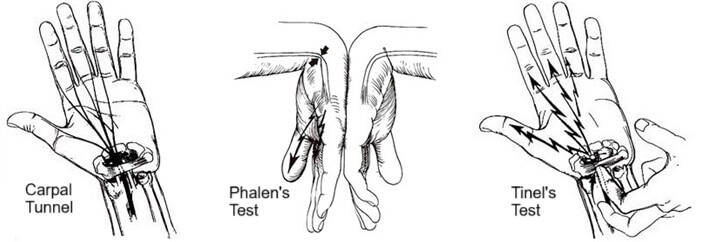
You may not need all of these carpal tunnel tests, often your doctor can accurately diagnose the condition from your history and physical exam. If you have a positive Tinel’s test or Phalen’s test, then carpal tunnel syndrome is the most likely diagnosis. If this is not sounding like your problem, check out the central wrist pain article or our wrist pain charts which will help you work out what is going on.
#CommissionsEarned from Amazon on qualifying purchases
How To Treat Carpal Tunnel
Carpal tunnel treatment depends on the severity and persistence of the condition. Mild to moderate cases can often be managed with non-surgical treatments such as:
- Activity Modification: Avoid repetitive hand/wrist movements or sustained positions, and any activities that aggravate your symptoms. Taking regular breaks during tasks can help relieve symptoms. If you spend a lot of time on the computer, switch to an ergonomic carpal tunnel mouse and keyboard pad to reduce pressure on the nerve
- Wrist Splints: Wearing a carpal tunnel splint, especially at night, can keep the wrist in a neutral position, reducing pressure on the nerve. If there are aggravating activities that you can’t avoid during the day e.g. lifting an infant, wearing a carpal tunnel brace can help reduce nerve irritation, but make sure you remove it periodically to prevent wrist stiffness developing
- Ice Treatment: regularly applying ice packs over the front of the wrist can help reduce inflammation around the nerve
- Medications: Nonsteroidal anti-inflammatory drugs (NSAIDs) like ibuprofen can help reduce pain and inflammation, but they only provide short-term relief and should be combined with other carpal tunnel treatments.
- Physical Therapy: Stretching, strengthening and neural gliding carpal tunnel exercises can really help improve wrist function and reduce symptoms, as well as preventing recurrence
- Carpal Tunnel Injections: Injecting corticosteroids e.g. cortisone into the wrist can reduce inflammation and pressure on the median nerve. Carpal tunnel injections may be carried out under ultrasound guidance to ensure accurate placement. They typically provide temporary relief so should be combined with other carpal tunnel treatments
Non-surgical carpal tunnel syndrome treatments tend to be most effective the earlier you start them after developing symptoms. Many cases will settle down with these treatments, but if symptoms are severe or persist for more than a year despite carpal tunnel treatment, then surgery may be recommended.
Carpal Tunnel Surgery
Carpal tunnel syndrome surgery aims to reduce the pressure on the median nerve by cutting the flexor retinaculum, the ligament that sits over the top of the nerve. This procedure is called a Carpal Tunnel Release or Carpal Tunnel Decompression.
The surgery increases the size of the carpal tunnel making more space for the median nerve and surrounding tendons, and restoring good blood flow to the nerve, so it can function properly.
There are two options with carpal tunnel release surgery:
- Open Carpal Tunnel Release: A small incision (2-3cm) is made in the palm, and the transverse carpal ligament is cut to release pressure on the nerve.
- Endoscopic Carpal Tunnel Release: A small camera is inserted into the wrist through tiny incisions, allowing the surgeon to cut the ligament with minimal tissue disruption.

Both procedures are generally effective with a success rate of over 90%. Endoscopic carpal tunnel release surgery typically results in less pain and a quicker recovery but it is not always appropriate.
Carpal Tunnel Surgery Recovery Time
Recovery time after carpal tunnel surgery varies depending on the type of procedure performed and individual healing rates. Generally:
- Initial Healing: Most patients experience relief from symptoms within a few days to weeks, particularly night-time symptoms, though mild discomfort may persist.
- Splint Use: A wrist splint is often worn for the first few weeks to protect the wrist and support healing.
- Return to Activities: Light activities can typically be resumed within a few weeks, while full recovery, including a return to strenuous tasks, may take 6-12 weeks or sometimes longer
- Grip Strength: it usually takes 2-3 months to regain grip and pinch strength, but can take longer if you strength was significantly reduced before surgery
- Physical Therapy: Hand therapy exercises can help restore strength and flexibility, speeding up recovery.
Mild pain, swelling and stiffness are normal after carpal tunnel release surgery and will usually settle within a few weeks to a few months
How to Prevent Carpal Tunnel
Preventing carpal tunnel syndrome involves reducing strain on the wrist and maintaining good ergonomic practices:
- Maintain Proper Wrist Posture: Keep wrists in a neutral position while working.
- Use Ergonomic Equipment: Keyboard pads, wrist supports, and an ergonomic mouse can reduce strain.
- Take Frequent Breaks: Stretching and resting your hands can help reduce repetitive stress.
- Strengthening Exercises: Hand and wrist exercises can improve strength, flexibility and reduce nerve tension.
- Maintain a Healthy Lifestyle: Managing conditions like diabetes and maintaining a healthy weight can lower the risk of CTS.
Carpal Tunnel Syndrome Summary
Carpal tunnel syndrome is a common condition that can cause significant discomfort in the wrist and hand and affect daily activities. It results from compression of the median nerve in the wrist and can be triggered by repetitive hand movements, medical conditions, or wrist injuries.
Carpal tunnel diagnosis involves physical tests e.g. Tinel’s test and nerve studies, while treatment options range from splints and medications to carpal tunnel release surgery for severe cases. Preventative measures, such as ergonomic adjustments and hand exercises, can help reduce the risk of developing CTS.
Early intervention and lifestyle modifications can improve outcomes and prevent long-term complications with carpal tunnel syndrome.
There are a number of other conditions that can cause wrist and hand pain. You may be interested in the following articles:
- Central Wrist Pain
- Wrist Fractures
- Wrist Tendonitis
- De Quervain's Tenosynovitis
- Intersection Syndrome
- Wrist Pain Diagnosis Charts
Related Articles
Rehab Exercises
December 12, 2023
Diagnosis Charts
February 11th, 2025
Elbow Diagnosis
January 28, 2025
Medical & Scientific References
- Carpal Tunnel Syndrome. National Library Of Medicine
- Carpal Tunnel Syndrome: Pathophysiology and Comprehensive Guidelines for Clinical Evaluation and Treatment. Cureus
- Carpal Tunnel Syndrome: Clinical Features, Diagnosis, And Management. The Lancet Neurology
- Personal Factors Associated With Carpal Tunnel Syndrome (CTS): A Case-Control Study. BMC Musculoskeletal Disorders
Page Last Updated: February 24th, 2025
Next Review Due: February 24th, 2027

